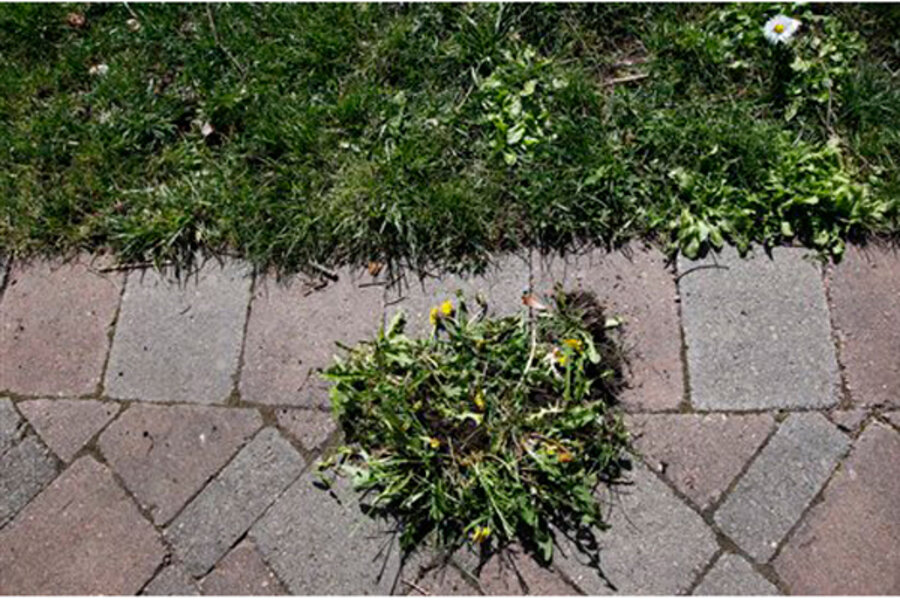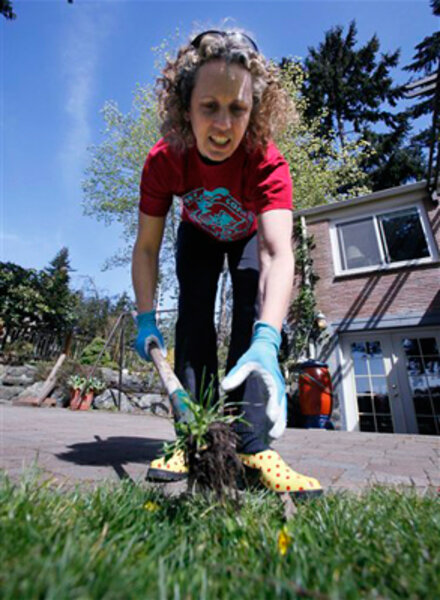Interest in organic lawn care is growing
Loading...
Lush green.
That's the way Jane Witmer describes the lawn around her Seattle house. But if you look closely, there's some moss and some clover. "Wildflowers are beginning to bloom pink in the grass," she said.
The small imperfections are the price she pays for keeping her lawn organic.
"It's better for my health, and the health of my pets and my family," Ms. Witmer said. "It's better for the health of the bugs and the birds in the yard."
Increasing numbers of homeowners are eschewing lawn chemicals, citing environmental and health concerns. A 2008 survey by the National Gardening Association indicated that about 12 million households were using only natural products on lawns and gardens, up from about 5 million in 2004.
Bruce Butterfield, market research director for the association, said the number of organic gardeners is likely to increase, to a point. "It's not going to totally displace use of conventional fertilizers for lawn care," he said.
"Part of it is the whole image of the way people see their lawns," he said. They're not going to get the country club or golf course look if they use only natural fertilizers.
At Scotts Miracle-Gro Co., organic products account for about 5 percent of overall sales of consumer lawn and garden products, according to Lance Latham, director of public affairs.
"In general, consumers will find the cost of organic fertilizers to be a little more than the price of conventional products," he said.
Going organic requires a bit of tolerance for weeds
People who choose to go organic might have to lower their expectations a bit, and be patient, the experts say.
"Organic approaches are not going to deliver the same pest control as chemicals," said Mike Goatley, extension turf grass specialist at Virginia Tech in Blacksburg.
Still, organic doesn't mean ugly, said Paul Tukey, founder of safelawns.org and author of "The Organic Lawn Care Manual." "You can have a gorgeous lush green lawn going naturally."
Just learn to tolerate some weeds.
Emily Bishton, a garden consultant and designer in Seattle, said she tries to get her clients at Green Light Gardening to envision what a natural grassland is like.
"The main thing that really needs to shift in terms of the way that you approach your lawn is that what you are striving for is how to make my grass as healthy as possible, rather than how do I get rid of these weeds," she said.
Weeds can help diagnose what's wrong with a lawn.
"Some weeds tell you your lawn is acidic," said Tukey. "Some weeds tell you your lawn is compacted. Some weeds tell you it's too wet."
Clover can be a sign the lawn needs nitrogen. Tukey calls clover "Mother Nature's fertilization factory."
In the middle of the 20th century, most grass seed was mixed with clover, which provides needed nitrogen to the soil, according to Goatley. "We're coming full circle," he said. "It makes perfect sense going in to fix the nitrogen."
Start with healthy soil
Good soil is the first step to a healthy lawn — organic or not.
Conduct a soil test, Goatley advised. "You've got to know what you're working with." You can do that through your local lawn and garden center or through state agriculture extension service programs.
Among the things you'll want to know: how much organic matter is in the lawn, the levels of such things as nitrogen, phosphorous and calcium, and the pH to determine if the soil is too acidic. A good pH to promote turf growth is generally considered to be between 6.5 and 7, Butterfield said.
The centers can give you advice on how to achieve the proper levels.
You'll also want to make sure your soil is properly aerated. Aerating a lawn provides room for roots to grow and allows it to hold water better. Earthworms do the aeration naturally. So does plantain. But if your lawn needs more help, there are aerating machines that you can buy or rent. Goatley recommends doing the aeration when the soil is moist.
To promote good growth, he said, soil should be about 50 percent solid material, 25 percent water and 25 percent pore space. A layer of compost helps give soil the ingredients it needs to provide a healthy environment for grass. Goatley recommends applying compost at a a depth of one-quarter inch once or twice a year.
For an organic fertilizer, some suggest corn gluten. However, using it in an urban area with rodents can be a problem, cautions Sandy Bandier, environmental and natural resources extension agent for the District of Columbia. Corn gluten can be feed for rats.
For many, the choice of going organic or synthetic doesn't have to be all or nothing. Some argue that if you are careful about using conventional fertilizers, they aren't all bad. "It's not a black and white picture," Butterfield said.
Besides, only about half of US households fertilize their lawn at all, he added. "They figure it's God's responsibility to make it look good."
-----
Editor's note: To read more about gardening, see the Monitor's main gardening page and our lively gardening blog, Diggin' It.






